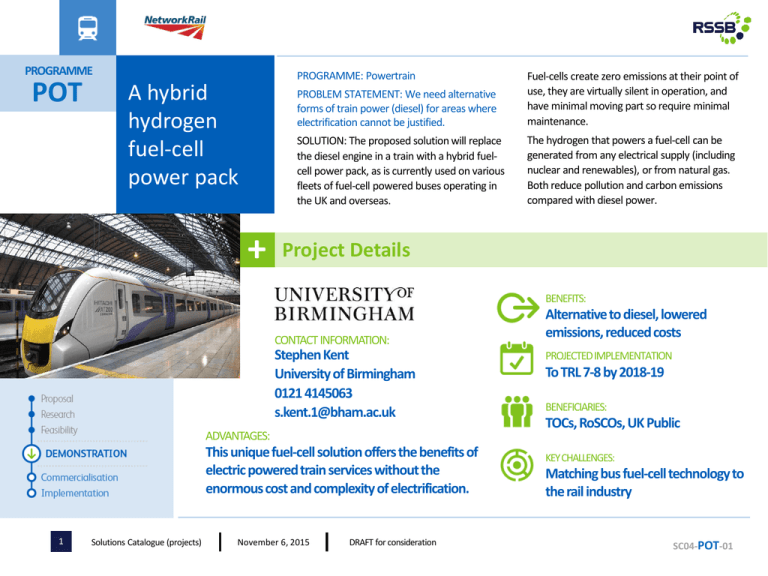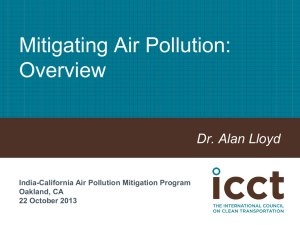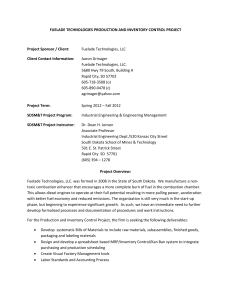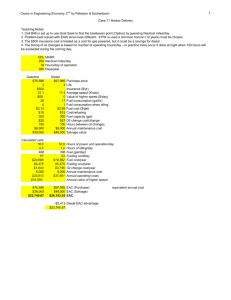POT A hybrid
advertisement

PROGRAMME POT PROGRAMME: Powertrain A hybrid hydrogen fuel-cell power pack + PROBLEM STATEMENT: We need alternative forms of train power (diesel) for areas where electrification cannot be justified. Fuel-cells create zero emissions at their point of use, they are virtually silent in operation, and have minimal moving part so require minimal maintenance. SOLUTION: The proposed solution will replace the diesel engine in a train with a hybrid fuelcell power pack, as is currently used on various fleets of fuel-cell powered buses operating in the UK and overseas. The hydrogen that powers a fuel-cell can be generated from any electrical supply (including nuclear and renewables), or from natural gas. Both reduce pollution and carbon emissions compared with diesel power. Project Details BENEFITS: CONTACT INFORMATION: Stephen Kent University of Birmingham 0121 4145063 s.kent.1@bham.ac.uk ADVANTAGES: This unique fuel-cell solution offers the benefits of electric powered train services without the enormous cost and complexity of electrification. 1 Solutions Catalogue (projects) November 6, 2015 DRAFT for consideration Alternative to diesel, lowered emissions, reduced costs PROJECTED IMPLEMENTATION To TRL 7-8 by 2018-19 BENEFICIARIES: TOCs, RoSCOs, UK Public KEYCHALLENGES: Matching bus fuel-cell technology to the rail industry SC04-POT-01 PROGRAMME POT PROGRAMME: Powertrain A hydrostatic transmission for the railway + PROBLEM STATEMENT: We need alternative forms of train power (diesel) for areas where electrification cannot be justified. SOLUTION: This project will feature a highefficiency transmission, the latest engine technology and new braking techniques. The new approach will significantly reduce energy consumption and operating costs and has the potential to reduce journey times through faster acceleration. The solution combines a hydrostatic transmission, modern engine technology and braking energy recovery to offer a step-change in performance. It offers a substantial fuel saving, low capital cost and long service life, and has potential for widespread adoption. Project Details BENEFITS: CONTACT INFORMATION: Stephen Laird Artemis Intelligent Power Ltd 0131 4406260 s.laird@artemisip.com ADVANTAGES: Digital Displacement® is a breakthrough technology for hydraulic machines and makes many new applications possible. 2 Solutions Catalogue (projects) November 6, 2015 DRAFT for consideration Increased capacity, reduced journey times, reduced fuel costs PROJECTED IMPLEMENTATION To TRL 7 by 2017 BENEFICIARIES: TOCs, RoSCOs, Passengers KEYCHALLENGES: Matching this technology to the rail industry SC04-POT-02 PROGRAMME POT PROGRAMME: Powertrain A dieselelectric hybrid power-pack + PROBLEM STATEMENT: We need alternative forms of train power (diesel) for areas where electrification cannot be justified. SOLUTION: The proposal is a diesel-electrichybrid power-pack solution for railcars. The pack will have a diesel engine that is smaller than the ones currently installed, an exhaust energy recovery device, and an energy storage system. All of these systems will be contained in a pack that will be installed under the floor of the railcar, enabling quick easy-access maintenance and replacement when necessary, ensuring higher vehicle availability. The design of the power-pack will permit the railcar to be powered via the on-board dieselhybrid system, and also offers the potential for power drawn from network electrification, taking advantage of the existing infrastructure. Project Details BENEFITS: CONTACT INFORMATION: Harry Evans WMG centre HVM Catapult 024 765 74521 harry.evans@warwick.ac.uk ADVANTAGES: The proposed removable power-pack for a dieselelectric-hybrid railcar will be highly efficient, be removable, and reduce exhaust emissions. 3 Solutions Catalogue (projects) November 6, 2015 DRAFT for consideration More efficient fuel usage, reduced emissions PROJECTED IMPLEMENTATION To TRL 4 by early 2016 BENEFICIARIES: TOCs, RoSCOs, public KEYCHALLENGES: Route to market, adapting technology to the UK environment SC04-POT-03 PROGRAMME POT A dual-fuel alternative for the rail industry PROGRAMME: Powertrain PROBLEM STATEMENT: We need alternative forms of train power (diesel) for areas where electrification cannot be justified. SOLUTION: This project is a demonstration of G-volution’s dual-fuel technology to reduce operating costs, lower emissions and adopt alternative fuels for diesel trains. G-volution is active in the field of dual or multifuel engines which using our patented + Optimiser control system evolve a diesel engine to a dual or multi-fuel unit. Our proposal is to adopt this technology for railway vehicles (multiple units), thus offering a route to lower operating cost, lower emissions and a route to the adoption of new, alternative and renewable fuels. This is in contrast to typical alternative uses in lower efficiency dedicated or monofuel spark ignition engines. Project Details BENEFITS: CONTACT INFORMATION: Chris Smith, Managing Director G-volution Plc 0163 3415311 Chris.smith@g-volution.com ADVANTAGES: G-volution’s technology permits existing engines to be evolved to dual-fuel powertrains without needing significant rebuilding of the vehicle. 4 Solutions Catalogue (projects) November 6, 2015 DRAFT for consideration Cleaner vehicles, reduced fuel costs, reduced emissions PROJECTED IMPLEMENTATION To TRL 6 by 2016-17 BENEFICIARIES: TOCs, RoSCOs, public KEYCHALLENGES: Matching this dual-fuel road technology to the rail industry SC04-POT-04 PROGRAMME POT Hybrid trains using automotive technology + PROGRAMME: Powertrain high voltage battery. PROBLEM STATEMENT: We need alternative forms of train power (diesel) for areas where electrification cannot be justified. It is an opportunity to use existing hybrid technology taken from the automotive industry that has been proven to reduce fuel consumption. SOLUTION: The HEMU (Hybrid Electric Multiple Unit) is a hybrid engine that will reduce the fuel consumption compared to a current rail engine. The hybrid powertrain uses an efficient diesel generator. It will maximise recovery of energy used for slowing down by charging a This technology can be particularly effective when the battery can be regeneratively charged (based on power released during braking) and discharge optimally using known topology of the route. Project Details BENEFITS: CONTACT INFORMATION: Duncan Holden R&D Vehicle Systems Ltd 01295 709595 duncan.holden@rdvs.co.uk ADVANTAGES: A railcar that uses the latest automotive hybrid, diesel, electric motor and battery technology to reduce fuel consumption. 5 Solutions Catalogue (projects) November 6, 2015 DRAFT for consideration Reduced fuel costs, reduced emissions PROJECTED IMPLEMENTATION To TRL 6-7 by early 2017 BENEFICIARIES: TOCs, RoSCOs, public KEYCHALLENGES: Route to market, patent issues around the technology SC04-POT-05 PROGRAMME POT PROGRAMME: Powertrain Low Cost Flywheel for Efficient Railways PROBLEM STATEMENT: We need alternative forms of train power (diesel) for areas where electrification cannot be justified. SOLUTION: The solution proposed is a ‘Low Cost Flywheel for Efficient Railways’. Use of a hybrid flywheel powertrain reduces emissions and fuel consumption by recovering braking energy. During existing non-electrified rail journeys, the + majority of the energy is lost as heat during frictional braking. Flywheel hybrid technology offers the best option for the recovery of this energy as they have a longer life expectancy and lower maintenance than batteries. This system will also reduce maintenance costs by reducing the wear on mechanical brakes and by removing the gearbox and drive-shafts. It also allows trains to run on electrified lines and store additional energy for later use. Project Details BENEFITS: CONTACT INFORMATION: Arnold Fenocchi Dynamic Boosting Systems Ltd 020 3417 4686 a.fenocchi@dynamicboost.com ADVANTAGES: DBS’ flywheel has a unique patented design which allows it to be safer and cheaper by limiting failure damage and increasing energy recovery. 6 Solutions Catalogue (projects) November 6, 2015 DRAFT for consideration More efficient fuel usage, reduced emissions PROJECTED IMPLEMENTATION To TRL 6-7 by 2017-18 BENEFICIARIES: TOCs, RoSCOs, public KEYCHALLENGES: Route to market, adapting to the UK rail environment SC04-POT-06 PROGRAMME POT A hydrogen fuel cell motor PROGRAMME: Powertrain electric power and water in the other direction. PROBLEM STATEMENT: We need alternative forms of train power (diesel) for areas where electrification cannot be justified. The reversible fuel-cell solution has greater energy storage than a battery. When stopped, if an overhead line is available, it can similarly absorb power from the grid. If not, it can run on hydrogen fuel cells. Moreover, hydrogen, which is sometimes called the “universal fuel”, may readily be produced from a variety of energy sources. SOLUTION: This solution is based on a reversible fuel-cell which can be used as a traction drive motor. This is an electrochemical device that provides power from hydrogen fuel when run in one direction, and provides hydrogen gas from + This has already been demonstrated in the US. Project Details BENEFITS: CONTACT INFORMATION: Arnold R. Miller Vehicle Projects Inc. +1 303 484 9522 arnold.miller@vehicleprojects.com ADVANTAGES: A hydrogen fuel cell, a uniquely versatile energy source, which has better storage than a battery and can absorb power from the grid when under overhead lines. 7 Solutions Catalogue (projects) November 6, 2015 DRAFT for consideration More efficient fuel usage, reduced emissions PROJECTED IMPLEMENTATION To TRL 6-7 by 2018 BENEFICIARIES: TOCs, RoSCOs, public KEYCHALLENGES: Route to market, adapting to the UK rail environment SC04-POT-07 PROGRAMME POT PROGRAMME: Powertrain Waste heat recovery for diesel vehicles PROBLEM STATEMENT: We need alternative forms of train power (diesel) for areas where electrification cannot be justified. SOLUTION: This project looks at adapting waste heat recovery technologies for diesel rail vehicles (diesel multiple units, DMU). Entropea Labs Limited and Brunel University have proposed a technology that consists of a mild-hybridisation of the DMU vehicle + powertrain to reduce fuel consumption and pollutant emission. A modular non-invasive Waste Heat Recovery System based on the Organic Rankine Cycle will be retrofitted to the DMU powertrain or placed on new vehicles. The proposed technology focuses towards a mild-hybrid configuration, allowing for a costeffective solution that improves the efficiency of a DMU vehicle. Project Details BENEFITS: CONTACT INFORMATION: Dr Benjamin Franchetti Entropea Labs Limited, London 0754 0176800 benjamin@entropea.com ADVANTAGES: The Waste Heat Recovery System based on the Organic Rankine Cycle is a novel concept to capture waste heat from combustion engines and convert it into useful energy. 8 Solutions Catalogue (projects) November 6, 2015 DRAFT for consideration Cleaner vehicles, reduced fuel costs, reduced emissions PROJECTED IMPLEMENTATION To TRL 7-8 by late 2017 BENEFICIARIES: TOCs, RoSCOs KEYCHALLENGES: Availability of a DMU to put the prototype on SC04-POT-09




